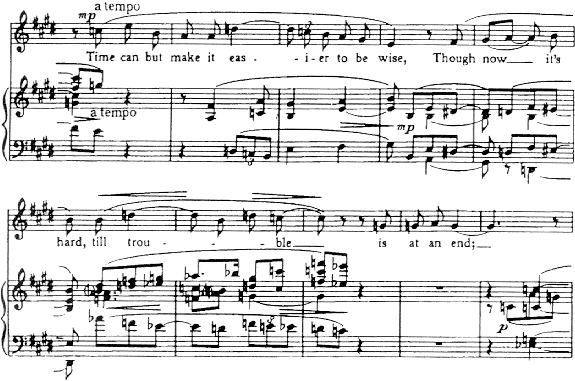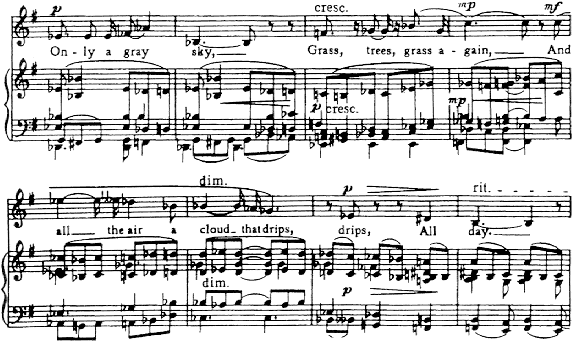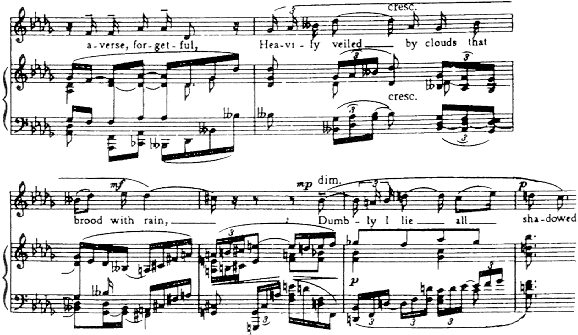The Rightness of Gurney

Gurney the musician
<< Continued from page 3
As Howells recalled, at the keyboard (including those dawn-chorus or
midnight-oil sessions at Minsterworth) Gurney tended to go for 'the big
line' of a work, 'less mindful of detail'. Given the background to his F.W.Harvey
song cycle (Minsterworth Perry etc.) and nightwalking songs, scarcely surprising
... [34] The same often suggests
itself of his compositional processes.
Howells's Music & Letters tribute remains one of the most
important, detailed and perceptive of all writings on Gurney's music, and
deserves to be required reading for all. Yet one should bear in mind its
date. Nor can one exclude, amid much loyal support and perceptive praise,
just a hint of patronage. Both Howells and Stanford, like others around
them [35], had to struggle (for
all their discipline) in different ways against the tendency - almost requirement
- to inflate and over-rhapsodise. Howells's celebrated Psalm-Preludes,
admirable though they be, are a case in point; some of his longer anthems,
another. [36]
A range of ingredients may stamp Gurney's name on a song; the casual,
easy flow of an unusually supple vocal line [37]; a brief rhapsodic uplift, studied flippancy or whimsical
turn; a dying fall, some moment of surpassing grace, an unexpected cadence;
or elsewhere, that ominous, ballad-quality, where he contrives to escape
the merely routine and formulaic; plus the constant, reassuring feel, as
Michael Hurd reminds us (Ordeal, p.208), that in Gurney 'voice and
piano are part of a unified texture'. [38]
The 'unified texture' can grow shaky, however: 'As so often with his
later songs, Gurney has attempted to carry his poem on a far-flung harmonic
span but has not quite reached the other side safely'. [39] So too 'his songs nearly always do complete their ideas,
and the endings are often exquisite, but the lack of balance or propulsion
experienced midway is often a severe weakness'. [40]
Still, time and again in Gurney, a damned-near-impossible sequence gets
where he wants it to, even if he has to emply Houdini-like methods to make
sure it does. [41] The more negative
elements - overtelescoping, curious modulatory crises that may intrude -
are reasonably easy to identify. The larger reasons for the success of the
overall span are harder to tie down.
Take this for example:

'The Folly of Being Comforted' (Songs 2, p.18)
Just how does he get away with that? Or this?

'Last Hours' (Songs 2, pp.26-27)
Or this?

'You are My Sky' (Songs 1, pp.22-23)
Often one has the inkling that there is some kind of 'rightness' - we
might even call it a 'Beethovenian' rightness - to Gurney's sense of direction
(even proportion) in certain apparently contorted development passages:
one which complements his talent for spinning anything from a simple, magical
four-square tune ('Down by the Salley Gardens') to a distended vocal aria.
The outcome of seeking and finding, rather than mere rambling: 'Rightness',
in not just a psychological [42]
but in an aesthetic, sense, mattered to Gurney, as he strove to quarry 'true
neatness' from his baroque and classical predecessors: [43] 'And poetry comes after eight miles' seeking | Mere
right out of mere love' ('Silver Birch', Poems, p.92; my italics).
In setting out the stall, I have dwelt perhaps too long here on the apparent
difficulties of Gurney's style. What of the positive? It is this 'rightness'
on which Michael Hurd focuses at the close of Ordeal that I should
like, tentatively, to pursue further in the second half of this article.
Others too may like to take up the cudgels on his behalf in future issues
of The Ivor Gurney Society Journal. [44]
Continue >> Notes >>
Copyright © Roderic Dunnett,
December 26th 1999
 << Music &
Vision homepage Leo Ornstein >>
<< Music &
Vision homepage Leo Ornstein >>
|